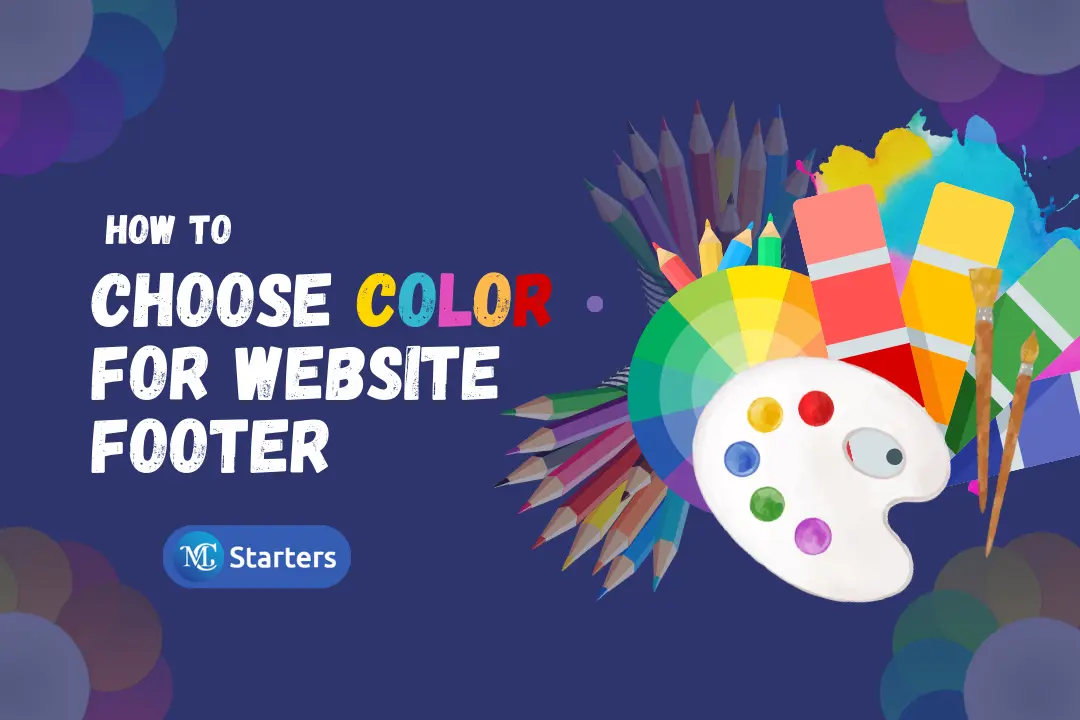How to Choose Color for Website Footer? A comphrensive guide

When setting up a website, selecting the right color for the footer is a crucial yet often overlooked aspect. The footer often contains vital information, and its color scheme can affect the overall aesthetics and user experience of the site.
Best WordPress Footer Design Samples (Examples)
Here is a detailed guide to help you choose the right color for website footer.
Consider Your Website’s Main Colors
Firstly, examine the dominant right color for website footer. These are the colors that are used most frequently in your design, maybe in the header, the logo, or the main content area. Try to choose a footer color that complements these colors harmoniously. It’s important to maintain a cohesive color scheme throughout the site for a professional and balanced look.
Keep It Simple
Simplicity is key when it comes to choosing a color for website footer. Avoid colors that are too bright or flashy, as they might distract users from the main content. Instead, opt for neutral or subdued hues that provide a clean and uncluttered appearance. This way, the footer will neatly round off your webpage without stealing the show.
- Simplicity: Choose a simple color scheme for the footer.
- Avoid Bright or Flashy Colors: Steer clear of colors that are overly bright or flashy, as they can distract users.
- Opt for Neutral or Subdued Hues: Instead, opt for neutral or subdued hues to provide a clean and uncluttered appearance.
- Consider Psychological Effects: Keep in mind the psychological effects of colors; neutral tones can evoke feelings of stability and calmness.
- Enhanced Readability: A simple color scheme ensures that text and other footer elements are easily readable.
- Faster Load Times: A minimalist approach to color choice can contribute to faster page load times, improving the user experience.
Check out best WordPress & Elementor footer templates
Think About the Readers
Remember to prioritize the comfort and experience of your readers. Select a color that doesn’t strain the eyes and ensures that the text or icons in the footer are easily readable. You might consider using contrasting colors to enhance readability. For instance, if the footer has a dark background, use light text, and vice versa. Choose the best color for website footer.
Test Different Colors
Before finalizing the color, experiment with different options to see which one suits best. You can use digital tools to preview how various colors look and to find the one that aligns well with your brand and website’s personality. Don’t hesitate to seek opinions from friends, family, or colleagues during this testing phase.
Get Feedback
After implementing your chosen color, consider collecting feedback from your audience. Their input can be invaluable, as they can provide a fresh perspective and might notice things that you may have missed. If you receive constructive feedback, be open to making adjustments to enhance the user experience.
Check out best WordPress & Divi footer layout
Be Willing to Make Adjustments
Even after finalizing a color, be open to making necessary adjustments based on user feedback and changing trends. The goal is to ensure that the footer remains an integral part of your website’s visual appeal and functionality.
Get Feedback
After implementing a color, gather feedback from a diverse group to understand their reactions and impressions, which can offer new perspectives and possibly lead to further refinements.
Be Willing to Make Adjustments
Stay open to making necessary adjustments based on user feedback and evolving trends. The goal is to maintain a footer that is both visually appealing and functional.
Consider the Impact on Load Time
When choosing a color for your footer, also think about how it might impact your website’s load time. Complex gradients or patterns might look appealing but can sometimes slow down the site. Opt for simpler color schemes that do not adversely affect the loading time, providing a smoother user experience.
- Page Load Time: The choice of footer color can impact the time it takes for your website pages to load.
- Complex Colors vs. Simplicity: Complex color schemes with gradients or intricate patterns can lead to longer loading times.
- Prioritize Speed: Opt for a simpler color scheme to ensure faster page load times, providing a better user experience.
- User Expectations: Users expect websites to load quickly; delays in loading can be frustrating and lead to a poor user experience.
- Reducing Bounce Rates: A faster-loading website is more likely to retain visitors and reduce bounce rates.
- Balancing Aesthetics and Performance: Striking a balance between visual appeal and website performance is crucial for a successful online presence.
Incorporate Brand Elements
Consider incorporating elements of your brand into the footer color choice. If your brand has specific colors that are used in the logo or other parts of the website, echoing these in the footer can help to create a unified brand image across the site.
Experiment with Textures or Patterns
While maintaining simplicity, don’t be afraid to experiment with subtle textures or patterns that can add depth and interest to your footer. This can be a creative way to make your footer visually engaging without using overly bright or flashy colors.
Monitor User Engagement
After implementing your chosen color, keep an eye on user engagement metrics. Sometimes, a color change can affect user behavior. Monitoring these metrics will help you understand if your color choice is aiding or hindering user engagement and adjust accordingly.
Regularly Update Based on Trends
Lastly, remember that website design trends change over time. Be ready to update color for website footer to keep up with the latest trends and user preferences, ensuring that your website remains modern and appealing.
Understanding the Psychology of Colors
In this section, delve deeper into the psychology of colors, explaining how different colors can influence the perceptions and behaviors of your website visitors. Offer insights into how to choose colors for website footer that not only look good but also align with the emotions and reactions you want to evoke in your audience.
The Role of the Footer in Website Design
Here, explore the critical role the footer plays in website design. Discuss how a well-designed footer can enhance the user experience by offering navigation aids, contact information, and other essential links. Emphasize the need for a color that complements the overall design and content of the footer.
- Navigation Aid: The footer serves as a valuable navigation aid, providing links to essential pages like the About Us, Contact, and Privacy Policy.
- Contact Information: It often contains crucial contact information, making it easy for users to get in touch with you.
- Social Media Links: Social media icons and links are commonly placed in the footer, connecting users to your online presence.
- Copyright and Legal Notices: The footer is a common location for copyright notices, disclaimers, and legal information.
- Enhanced User Experience: A well-designed footer can enhance the overall user experience by providing quick access to vital information.
- Complementary Color Choice: The footer’s color choice should complement the overall website design, creating a harmonious visual flow.
- Consistency: Consistency in color with the rest of the website ensures a cohesive and professional look.
- Balance: Balancing aesthetics and functionality is crucial when choosing a color for the footer to maintain the footer’s role in website design effectively.
Case Studies on Effective Footer Designs
In this section, we present case studies of websites with particularly effective footer designs. Discuss the color choices they made and how they complement their overall website design. This real-world evidence can provide readers with inspiration and concrete examples to follow.
Tools and Resources color for website footer
Here, list down some popular tools and resources that can help readers in selecting the perfect color for their website footer. Mention tools that allow for color palette selection, contrast checking, and accessibility testing.
Essential Tips for Selecting the Ideal Footer Color
- Consistency with Brand Identity: Ensure the footer color aligns with your brand colors to maintain a cohesive look.
- Simple is Better: Opt for a simple color scheme that is pleasing to the eyes and not too flashy or distracting.
- Prioritize Readability: Choose colors that enhance the readability of the text in the footer.
- Consider Emotional Responses: Remember that colors can evoke different emotions; select a color that resonates with your brand message.
- Accessibility Matters: Ensure that the color chosen is accessible to people with visual impairments, meeting necessary accessibility standards.
- Mobile Responsiveness: Test the color on different devices to ensure it remains attractive and functional on mobile screens.
- Fast Load Time: Choose colors or patterns that do not significantly slow down the website’s load time.
- Incorporate Brand Elements: Consider integrating some elements of your brand into the footer color for a unified look.
- Experiment Wisely: While keeping it simple, experiment with textures or patterns that can add a touch of creativity to your footer.
- Feedback is Key: Gather feedback from a diverse group of users to understand different perspectives and possibly refine your choice further.
- Willingness to Adjust: Be willing to make adjustments based on user feedback and changing trends.
- Monitor User Engagement: Keep an eye on how the color choice affects user engagement and be ready to make adjustments if necessary.
- Stay Updated with Trends: Regularly update the footer color based on evolving design trends to keep your website modern and engaging.
conclusions
Choosing the right color for website footer is not just a matter of aesthetic appeal, but also a vital aspect in crafting a user-friendly and cohesive website experience. As we navigate through the various considerations, from understanding color psychology to the crucial role of a footer, it is apparent that this seemingly minor detail can have a profound impact on your website’s overall appeal and effectiveness.
We hope this guide serves as a helpful roadmap as you work towards crafting a website footer that is not only visually appealing but also enhances the usability and appeal of your website. Good luck!
What is the best color for website footer?
The best color for a website footer depends on your brand, but neutral or complementary colors often work well.
How do I make my footer a different color?
You can make your footer a different color by customizing the CSS or design settings of your website.
How do I choose a color scheme for my website?
Choose a color scheme for your website based on your brand, audience, and the emotions you want to convey.
Should the header and footer be the same color?
The header and footer don’t have to be the same color, but they should harmonize and complement your website’s overall design.




